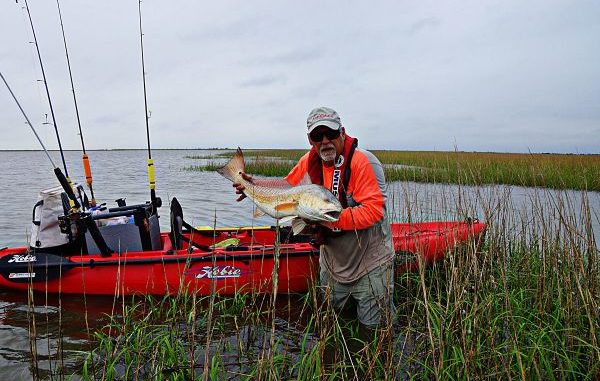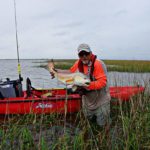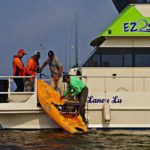
Mothership provides access to new waters
Although likely to be seen near any popular fishing spot in Louisiana, there are still times when kayakers get even stranger looks.
It’s that look of bewilderment when a powerboat fisherman comes across a kayak fisherman many miles from the nearest launch site. How did they get there?
“Mothershipping” is using a powered vessel to carry a kayak or group of kayaks to areas not accessible by human power alone. The urge to fish areas unknown appeals to kayak fishermen, and mothershipping is the only viable way to do it.
Enter the Miss Laney Lu, a 50-foot Gaudet aluminum houseboat christened early summer.
The boat is captained by Greg Stretcher, and has been primarily used for group night-fishing trips, as well as a “floating hotel” for anglers who want a place to stay on the water near their fishing grounds. The boat is equipped with all the amenities of home, and sleeps six in its spacious cabin.
Capt. Greg saw another use for the Miss Laney Lu. The ample front deck looked perfect for stacking kayaks and taking them to places they have never been.
Fourchon is the Lu’s home port and a popular destination for kayak fishermen. There’s a public boat launch and countless places to “combat launch” off of Highway 1. However, there’s always that desire to go farther and check out new waters.
On a recent Friday morning, four kayak buddies dragged their ’yaks to Fourchon to make a maiden voyage to parts unknown. After loading the yaks and all their gear aboard, Capt. Greg was wondering if he needed a bigger boat.
“The kayakers are onboard — man, they have a lot of stuff,” he said.
It was easy to see that kayak fishing is not the minimalist sport it was in the early days. Depth finder/GPS combos, crates filled with tackle and seats that rival your favorite lounge chair made for some serious fishing machines. Of course, each angler had also brought along enough rod and reel combos to outfit a tackle store.
“Where are we heading?” asked Hobie Team pro Vlad Moldoveanu, as if by knowing the name he’d have any better idea.
The Miss Laney Lu was headed toward the Fornation Islands, a few miles north of Timbalier. Capt. Greg was familiar with this expanse of protected islands and near endless oyster reef area.
However, it’s fairly shallow and gets virtually no fishing pressure from the larger powerboats due to the depth restrictions.
“I know there are lots of fish up in those ponds, but all the bigger boats that fish way out here can’t get to them,” he said. “I’ve been thinking for a while that this is a perfect area to explore and fish via kayak.”
As luck usually dictates, the wind for the two days of the trip was relentless. Muddy water was everywhere, and whitecaps were seen in all directions.
After a few hours, Capt. Greg motored the houseboat into the mouth of a small cove, where we could hide a bit from the wind. This would be the base of operations and home for the night.
The anglers climbed the stairs to the bridge to get a look over the area from the higher vantage point. It was clear to see that the Fornation Islands offered miles of pockets, ponds and coves that just waited to be explored. It was a kayaker’s dream, as many of these places were rarely, if ever fished.
The ’yakers readied their gear and were eager to ply these new waters. One by one, the kayaks were launched and tied to the railing. With waves bucking against the houseboat, the anglers took their turns getting onboard, like bull riders getting set in the chute.
Rods, gear and other essentials were handed over the rail, the rope was pulled and they were off. After a short, but wet paddle around a corner, the island mass knocked the wind down and the conditions were much more manageable. The water was still like chocolate milk, and the prospect of catching fish was less than optimum.
The group quickly dispersed, with each ’yaker seeking more protection from the wind and searching for elusive clean(er) water.
In less than 10 minutes, I connected with the first fish of the trip. At the back of a cove, I saw a small mullet jump, and sailed a Top Dog to the exact spot. The second it hit the water, a big red swirled and inhaled it.
After a prolonged fight with the big fish, the red was successfully netted and brought onboard for a photo op. With the presence of fish confirmed, we now just had to catch them.
With the abundance of oysters in the area, there was no doubt reds would be nearby. However, another member of the drum family — the black drum — was also present. Tails as big as 12 inches wide were regularly seen above the water as the big drum grubbed around the reefs.
If you wanted to fight one, a Gulp on a jighead was all you needed to drag past its nose. Not good to eat, but a great battle in the kayaks.
As the sun set, the anglers made their way back to the houseboat each having discovered new territory and battled a few fish.
The night was spent grilling steaks on the top deck and capped off by watching an LSU baseball game on the satellite TV. As they say: It doesn’t get much better than this.
Another benefit of a mothership trip is the nighttime fishing under the Miss Laney Lu’s six giant lights. Had the water clarity been a little more than none, trout and assorted species would have flocked to the boat.
Unfortunately, not that night.
After a comfortable night’s sleep, the ’yaks were splashed again for a morning trip and some more tug of war with trout and reds. The group explored new waters until about noon, and then loaded up to head back to Fourchon, with each angler already talking about the next mothership trip.
There is a whole lot of territory out there just begging for kayak anglers to explore. A mothership trip on the Miss Laney Lu will get you there in comfort and style.
You’ll have access to areas virtually untouched and a sense of adventure that can’t be had launching off the side of the road.
For more info, go to www.ex2seacharters.com or look for Greg Stroscher on Facebook.




